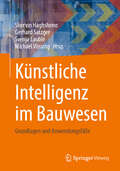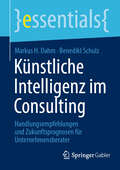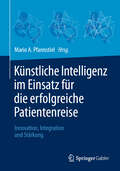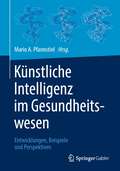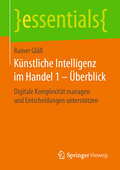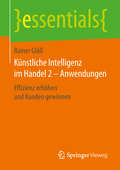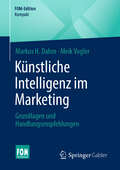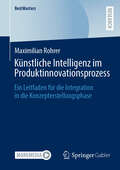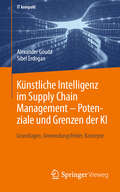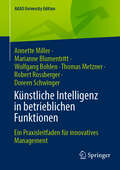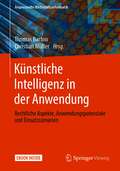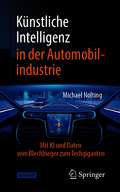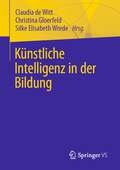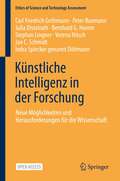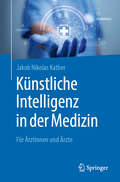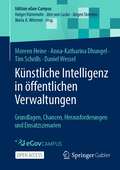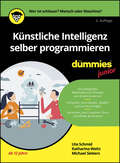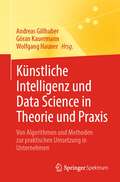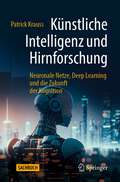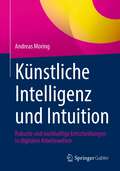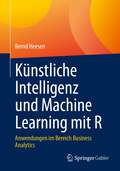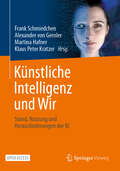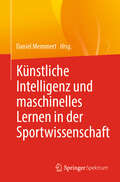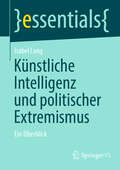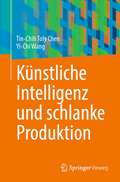- Table View
- List View
Künstliche Intelligenz im Bauwesen: Grundlagen und Anwendungsfälle
by Gerhard Satzger Shervin Haghsheno Svenja Lauble Michael VössingDieses Fachbuch demonstriert das Potenzial Künstlicher Intelligenz (KI) im Bauwesen. Die rasant wachsende Menge an Daten sowie die in Bauprojekten eingesetzte Hard- und Software bilden die Grundlage für projektübergreifende und vorausschauende Analysen, die u.a. durch Ansätze des maschinellen Lernens und der Robotik ermöglicht werden.Die einzelnen Beiträge dieses Buches geben einen allgemeinen Überblick über Methoden der Künstlichen Intelligenz (KI) und veranschaulichen deren Einsatz im Bauwesen anhand konkreter Anwendungsfälle aus Forschung und Praxis. KI-Methoden versprechen hier sowohl Effizienzgewinne und Fehlerreduzierung durch Automatisierung repetitiver Tätigkeiten als auch völlig neue Möglichkeiten der Entscheidungsunterstützung in Bauplanung, -ausführung und -betrieb. Die Publikation richtet sich insbesondere an Führungskräfte und Fachexperten der Bauwirtschaft, die mit KI-Methoden eine nachhaltige Verbesserung ihrer Unternehmensprozesse erreichen wollen.
Künstliche Intelligenz im Consulting: Handlungsempfehlungen und Zukunftsprognosen für Unternehmensberater (essentials)
by Markus H. Dahm Benedikt SchulzDieses Buch befasst sich mit den aktuellen und zukünftigen Einflüssen von künstlicher Intelligenz auf die Branche und den Beruf der Unternehmensberatung. Im Fokus stehen dabei die Möglichkeiten der Delegation von Aufgaben an KI-Anwendungen sowie die Auswirkungen von KI auf die Anforderungen und Tätigkeiten in der Beratung. Abgerundet wird die Darstellung durch konkrete Handlungsempfehlungen für heutige und zukünftige Berater im Hinblick auf den eigenen Umgang und die Positionierung im Themenfeld KI.
Künstliche Intelligenz im Einsatz für die erfolgreiche Patientenreise: Innovation, Integration und Stärkung
by Mario A. PfannstielIn diesem Fachbuch steht die Perfektionierung der Patientenreise im Fokus, indem KI(-Management) als Schlüsselfaktor im Gesundheitswesen betrachtet wird. Die strategische Ausrichtung von KI basiert auf drei Schlüsselprinzipien: Innovation, Integration und Stärkung. Der Buchinhalt soll sich auf vier Teile aufgliedern, beginnend mit der Bedeutung der Patientenreise im Gesundheitswesen, gefolgt von der Rolle von KI(-Management) in dieser Reise. Anschließend sollen die Optimierung der Patientenreise durch KI(-Management) aufgezeigt und Erfolgsfaktoren sowie Best Practices dargestellt werden.
Künstliche Intelligenz im Gesundheitswesen: Entwicklungen, Beispiele und Perspektiven
by Mario A. PfannstielKünstliche Intelligenz (KI) nimmt schon heute Einfluss auf Beruf und Alltag und begleitet die Menschen bei der Erledigung von Arbeitsaufgaben. Im Gesundheitswesen gilt KI als Schlüsseltechnologie und als Motor für Fortschritt und Beschäftigung. Neue Algorithmen tragen dazu bei, dass KI zum Game Changer im Gesundheitsmarkt wird. Herkömmliche Behandlungswege bei der Diagnostik und bei der Therapie von Patienten verändern sich. Medizinisches und pflegerisches Personal soll durch den Einsatz von KI unterstützt und entlastet werden. Künstliche Intelligenz verspricht einen hohen Nutzen für Individuen und Unternehmen. Dabei sind jedoch auch die sozialen, finanziellen, technischen und rechtlichen Rahmenbedingungen zu berücksichtigen. Trotz der vielfältigen Möglichkeiten ist der Einsatz der Künstlichen Intelligenz bei personenbezogenen Daten und in bestimmten Geschäftsmodellen kritisch zu hinterfragen und zu reflektieren.Das vorliegende Herausgeberwerk gibt einen Überblick zu aktuellen - bisweilen kontrovers diskutierten - Themen aus Theorie, Forschung, Transfer und Praxis. In 43 Beiträgen stellen 82 renommierte Autoren und Experten ihr Wissen, ihre Erkenntnisse, Erfahrungen und Einschätzungen vor. Es werden Lösungsansätze und Problemfelder beim Einsatz von Künstlicher Intelligenz im Gesundheitswesen aufgezeigt. Durch eine anschauliche Clusterung und Einordung der Buchbeiträge in themenbezogenen Übersichten eignet sich das Werk sowohl für Einsteiger als auch für Praktiker und Wissenschaftler.
Künstliche Intelligenz im Handel 1 – Überblick: Digitale Komplexität managen und Entscheidungen unterstützen (essentials)
by Rainer GläßDieses essential gibt einen Überblick über Künstliche Intelligenz im Handel und zeigt auf, wie mithilfe künstlicher Intelligenz innovative Dienste für Kunden entstehen sowie für unternehmensinterne Prozesse automatisiert werden. Es wird beschrieben, wie Unternehmen Lösungen auf der Basis von Künstlicher Intelligenz erfolgreich einführen können. Zu diesem essential gibt es einen ergänzenden Band desselben Autors mit konkreten Anwendungen aus der Praxis.
Künstliche Intelligenz im Handel 2 – Anwendungen
by Rainer GläßDieses essential zeigt anhand konkreter Beispiele die Umsetzung und Implementierung von Künstlicher Intelligenz im Handel. Vorgestellt werden Anwendungsfelder von KI im Handel – in spezifischen Handelsprozessen von Kundenmanagement bis Controlling, in der Bedarfsplanung und Logistik, in der Preisgestaltung (Dynamic Pricing), im vollautomatisierten Store sowie Chatbots im Kundenservice zur Verbesserung der Customer Experience. Beispiele von KI-Anwendungen aus stationärem und Onlinehandel und der Mode-(Fashion)Branche.
Künstliche Intelligenz im Marketing: Grundlagen und Handlungsempfehlungen (FOM-Edition)
by Markus H. Dahm Meik VoglerDas Buch zeigt, wie Marketing durch KI effizienter und erfolgreicher gestaltet werden kann. Die Autoren vermitteln nicht nur theoretisches Wissen, sondern geben auch praxisnahe Einblicke, Anwendungsbeispiele und konkrete Handlungsempfehlungen. Sie verdeutlichen die leise Disruption durch KI im Marketing und bieten Orientierung in Zeiten des Wandels. Mit einem klaren „act now“ werden Sie dazu aufgerufen, die Chance im Marketing der Zukunft zu ergreifen und die eigene Position zu festigen.
Künstliche Intelligenz im Produktinnovationsprozess: Ein Leitfaden für die Integration in die Konzepterstellungsphase (BestMasters)
by Maximilian RohrerMit dem Aufkommen von OpenAIs ChatGPT hat die künstliche Intelligenz auch Einzug in das Innovationsmanagement gehalten. Hierbei zeigt sich, dass es bisher keine einheitliche Vorgehensweise zur Integration dieser in den Innovationsprozess gibt. Besonders in der Konzepterstellungsphase eines Innovationsprozesses wird KI bisher kaum eingesetzt. Das Buch zielt darauf ab, die spezifischen Aufgaben und Herausforderungen in der Konzepterstellungsphase zu identifizieren und zu untersuchen, ob und wie KI effektiv eingesetzt werden kann. Der daraus resultierende Leitfaden bietet konkrete Anweisungen zur Integration von KI in definierte Use Cases und hebt wichtige Überlegungen hervor, die bei der Implementierung beachtet werden sollten, um den Innovationsprozess zu optimieren.
Künstliche Intelligenz im Supply Chain Management – Potenziale und Grenzen der KI: Grundlagen, Anwendungsfelder, Konzepte (IT kompakt)
by Alexander Goudz Sibel ErdoganKomplexität, Vernetzung und Digitalisierung prägen heute die moderne Geschäftswelt. Die Notwendigkeit für Unternehmen, ihre Liefernetzwerke künftig resilienter gegen externe Einflüsse aufzustellen, ist bereits heute deutlich erkennbar. Veränderungen durch Klimawandel, Pandemien oder Versorgungsengpässe erschweren die Handhabung. KI-Technologien können dabei eine wertvolle Unterstützung leisten. Das vorliegende Buch soll ein grundlegendes Verständnis über die KI-Technologien vermitteln und insbesondere den Fokus auf die Konzeptentwicklung im SCM legen.
Künstliche Intelligenz in betrieblichen Funktionen: Ein Praxisleitfaden für innovatives Management (AKAD University Edition)
by Marianne Blumentritt Annette Miller Wolfgang Bohlen Thomas Metzner Robert Rossberger Doreen SchwingerZwar nutzen bereits viele Beschäftigten KI-Tools in ihrer täglichen Arbeit - auch ohne dass diese von ihren Firmen bereitgestellt werden -, eine konsistente Unternehmens-KI-Strategie ist bislang jedoch noch selten in den KMUs anzutreffen. Dabei sollte Künstliche Intelligenz nicht nur als Instrument zur Sicherung der Wettbewerbsfähigkeit betrachtet werden, sondern auch zur Lösung einiger zentraler aktueller Herausforderungen, wie z.B. dem Fachkräftemangel oder hoher bürokratischer Anforderungen, beitragen können. Dieses Buch zielt darauf ab, die bisher zögerliche Verbreitung von KI in der Wirtschaft anzukurbeln und zu einem strategischen Einsatz zu motivieren. Übersichtlich und klar strukturiert, zeigt es die innovativen Potenziale von KI auch für kleinere und mittlere Unternehmen in bestehenden Prozessen auf. Anhand von Fallbeispielen und konkreten Tools werden insbesondere die Möglichkeiten von KI in den betrieblichen Funktionen Personal, Rechnungswesen und Controlling, Logistik sowie Marketing und strategisches Management präsentiert. Eine lohnende Lektüre für alle Fach- und Führungskräfte, die mit KI-Unterstützung die unternehmerische Zukunft gestalten und anstehende wirtschaftliche Herausforderungen meistern wollen.
Künstliche Intelligenz in der Anwendung: Rechtliche Aspekte, Anwendungspotenziale und Einsatzszenarien (Angewandte Wirtschaftsinformatik)
by Thomas Barton Christian MüllerDas Buch zeigt Anwendungspotenziale von Künstlicher Intelligenz in verschiedenen Branchen und stellt Einsatzszenarien vor, wie eine praktische Umsetzung erfolgen kann. Ausgangsbasis ist die Beschreibung rechtlicher Aspekte, die eine europäische Regelung für Künstliche Intelligenz umfasst und die Frage nach der Zulässigkeit automatisierter Entscheidungen zum Gegenstand hat. Die Beschreibung verschiedener meist branchenbezogener Anwendungspotenziale und die Vorstellung einiger Einsatzszenarien bilden den Schwerpunkt des Themenbandes. Das Buch basiert auf der Fragestellung, wie Künstliche Intelligenz in der unternehmerischen Praxis eingesetzt werden kann. Es bietet wichtige Informationen, die für Praktiker ebenso relevant sind wie für Studierende und Lehrende.
Künstliche Intelligenz in der Automobilindustrie: Mit KI und Daten vom Blechbieger zum Techgiganten (Technik im Fokus)
by Michael NoltingDieses Buch öffnet Ihnen die Augen, wie Künstliche Intelligenz die Automobilindustrie nachhaltig disrumpieren wird. Um diese Disruption zu meistern, müssen Automobilhersteller das volle Potential aus ihren Daten schöpfen, und in der Lage sein, täglich neue Dienste an ihre Kunden auszuspielen. Dieses Buch zeigt die dazu notwendigen Transformationen auf: Vom Aufbau einer tragfähigen Vision bis hin zur technologischen und organisatorischen Umsetzung im Unternehmen. Auf dieser Basis können sich die Automobilhersteller vom Blechbieger zum Techgiganten transformieren. In über 100 Fallbeispielen entlang der automobilen Wertschöpfungskette wird aufgezeigt, wo Künstliche Intelligenz einen Mehrwert liefern kann. Auf das autonome Fahren als wichtiger Enabler wird eingegangen sowie auf die wichtigsten Verfahren der Künstlichen Intelligenz, die für die Automobilindustrie relevant sind. Das Buch richtet sich an Entscheider in der Automobilindustrie, Studierende, Dozenten und alle, die sich ein Bild über eine der vielleicht größten industriellen Transformationen dieses Jahrhunderts machen möchten.
Künstliche Intelligenz in der Bildung
by Claudia De Witt Christina Gloerfeld Silke Elisabeth WredeDer Band geht von einer bildungswissenschaftlichen Perspektive auf Künstliche Intelligenz (KI) aus. Er enthält bildungstheoretische Standpunkte zum Einfluss von KI auf Bildung und stellt didaktische Positionen bzw. Gestaltungsansätze von KI in Schule, der beruflichen (Weiter-)Bildung und Hochschulbildung vor. Neben Ansätzen zur Kompetenzentwicklung mit KI in der Bildungspraxis hebt der Band zudem den erklärbaren, ethisch orientierten und souverän beherrschbaren Umgang mit KI hervor.
Künstliche Intelligenz in der Forschung: Neue Möglichkeiten und Herausforderungen für die Wissenschaft (Ethics of Science and Technology Assessment #48)
by Peter Buxmann Jan C. Schmidt Carl Friedrich Gethmann Julia Distelrath Bernhard G. Humm Stephan Lingner Verena Nitsch Indra Spiecker genannt DöhmannDieses Buch ist eine Open Access Publikation.Der lange gehegte Traum von künstlicher Intelligenz (KI) wird in unserer Alltagswelt zunehmend Realität. Damit verbinden sich hohe gesellschaftliche Erwartungen, aber auch Sorgen hinsichtlich einer schleichenden Entmündigung des Menschen. Am Beispiel des Forschungssektors lotet dieser Band die Optionen, Entwicklungschancen und Risiken von KI-Techniken für die Zukunft des wissenschaftlichen Erkenntnisprozesses und der darauf beruhenden technischen Entwicklungen aus. Zu diesem Zweck wird zunächst der Stand der KI-Technik und ihrer Anwendungen dargestellt. Es folgen wissenschaftsphilosophische Untersuchungen zur Frage der Ersetzbarkeit des forschenden Menschen durch KI und zu erwartenden Veränderungen in der wissenschaftlichen Forschung. Weitere Abschnitte widmen sich den Folgen für die Arbeitswelt von Forschern/Forscherinnen sowie den durch KI erzeugten neuen Herausforderungen für die rechtliche Regulierung im Spannungsfeld von Wissenschaftsfreiheit und Datenschutz. Der Band schließt mit Empfehlungen für die verantwortlichen Akteure in Wissenschaft, Forschungspolitik und Gesellschaft aus interdisziplinärer Perspektive.
Künstliche Intelligenz in der Medizin: Für Ärztinnen und Ärzte
by Jakob Nikolas KatherWie funktionieren Sprachmodelle? Welche ethischen Fragen stellen sich bei der Anwendung von KI? Und was kann KI in der Medizin und was nicht? In der Medizin besteht auf allen Ebenen ein großer Bedarf, mehr über KI zu lernen. Antworten auf diese und viele weitere Fragen gibt Ihnen dieses Buch. Von den Grundlagen der KI allgemein über KI in der klinischen Praxis und Forschung bis hin zu offenen Fragestellungen beleuchtet der Autor die relevanten Aspekte der KI für die Medizin. Zahlreiche Beispiele und Entwicklungsmöglichkeiten geben eine Momentaufnahme und einen Ausblick auf eine innovative Medizinlandschaft, in der KI und menschliche Expertise sich gegenseitig ergänzen.
Künstliche Intelligenz in öffentlichen Verwaltungen: Grundlagen, Chancen, Herausforderungen und Einsatzszenarien (Edition eGov-Campus)
by Moreen Heine Anna-Katharina Dhungel Tim Schrills Daniel WesselDieses Buch – eine Open-Access-Publikation mit freiem Online-Zugang – bietet eine verständliche und kompakte Einführung in die Nutzung von KI-Systemen in öffentlichen Verwaltungen. Es beantwortet folgende Fragen: Was bedeutet Künstliche Intelligenz? Wie und in welchen Einsatzgebieten können KI-Systeme im öffentlichen Sektor genutzt werden. Welche Erwartungen und Ziele werden mit dem KI-Einsatz verbunden? Welche Probleme werden adressiert? Auch Aspekte der Governance, also Steuerungsfragen, spielen eine Rolle. Ein besonderer Schwerpunkt liegt auf der Betrachtung der Beziehung und Interaktionen zwischen Mensch und KI-System. Dabei wird auch die Erklärbarkeit der Funktionsweise eines KI-Systems erläutert. Die Inhalte sollen Personen in die Lage versetzen, den Einsatz von KI in der öffentlichen Verwaltung differenziert beurteilen zu können.Kenntnisse im Bereich der Informatik werden nicht vorausgesetzt. Nach dem Lesen dieses Buches sind Sie in der Lage,KI-Anwendungsfälle und Potenziale im öffentlichen Sektor zu identifizieren,KI-Methoden im Überblick zu verstehen,Grenzen und Herausforderungen bei der Anwendung im öffentlichen Sektor zu diskutieren undAnforderungen an KI-Anwendungen im öffentlichen Sektor zu erarbeiten.Im Sinne von Offenheit ist dieses Werk eine Open-Access-Publikation mit freiem Online-Zugang.Inklusive kostenlosem Online-Wissens-Quiz mit der Springer Nature Flashcards-App: Der Fragensatz mit 78 Fragen und Antworten in den SN Flashcards beinhaltet Wiederholungs- und Vertiefungsfragen zum Lehrbuch „KI in öffentlichen Verwaltungen“. Die Fragen und Antworten vermitteln spielerisch wichtige Begriffe, Hintergründe und Wissenswertes zum Thema.
Künstliche Intelligenz selber programmieren für Dummies Junior (Für Dummies)
by Ute Schmid Katharina Weitz Michael SiebersWas können intelligente Computer – und was nicht? Finde heraus, wie Künstliche Intelligenz funktioniert. Dieses Buch hilft dir dabei. Kapitel für Kapitel beantwortet es folgende Fragen: Was ist Künstliche Intelligenz? Wie denken Computer? Wie lernen Computer? Wie kannst du mit Computern sprechen? Wie generieren Computer Texte und Bilder? Spielen Computer auch? Und können Computer fühlen? Grundlegende Methoden und Anwendungsbereiche von Künstlicher Intelligenz werden anhand von anschaulichen Beispielen erklärt. Beispielprogramme in Python zeigen, wie KI-Methoden konkret umgesetzt werden können und es werden Anregungen für eigene Experimente gegeben. Du lernst Gemeinsamkeiten und Unterschiede zwischen menschlichem Denken und KI Wie Programme funktio-nieren, die lernen können Wie du einen eigenen Chatbot programmieren kannst Wie du einem Computer beibringen kannst, gegen dich Tic-Tac-Toe zu spielen
Künstliche Intelligenz und Data Science in Theorie und Praxis: Von Algorithmen und Methoden zur praktischen Umsetzung in Unternehmen
by Göran Kauermann Andreas Gillhuber Wolfgang HaunerDieser Sammelband verbindet theoretische Grundlagen und praktische Anwendungen von Künstlicher Intelligenz (KI) und Data Science: Anerkannte Experten stellen in ihren Beiträgen den aktuellen Stand in Forschung und Wirtschaft dar – und bieten so einen einzigartigen Überblick über aktuelle Konzepte und ihre Umsetzung in Unternehmen. Im ersten Teil des Buchs werden die Methoden und Algorithmen skizziert, die sich größtenteils aus einer Kombination von Statistik und Informatik ergeben und auf Verfahren des Maschinellen Lernens bis hin zu Deep Learning und KI basieren. Im zweiten Teil wird die konzeptionelle Umsetzung in der Praxis skizziert: Hier wird insbesondere aufgezeigt, welche Herausforderungen in der Praxis auftreten – ob nun bei der Einbettung der Daten-Use-Cases in eine Gesamtstrategie oder bei der Produktivsetzung, Weiterentwicklung und dem Betrieb von Daten-basierten Lösungen. Der dritte Teil zeigt das breite Potpourri von Data Science in der Praxis: Branchengrößen wie Allianz, ADAC, BMW, Deutsche Bahn, Lufthansa, REWE, RTL, St. Galler Stadtwerke, SwissRe und viele weitere zeigen konkret, welche Erfahrungen sie bei ihren Projekten gesammelt haben. Fachartikel von über 20 namhaften Unternehmen decken die spezifischen Anforderungen ihrer jeweiligen Branchen ab. Das Buch möchte die interdisziplinäre Diskussion und Kooperation zwischen Wissenschaft und Wirtschaft fördern und richtet sich daher an verschiedene Lesergruppen:Studierende und Absolventen, die Orientierung für die eigene Laufbahn suchen.Forschende und Lehrende, die einen Einblick in praxisrelevante Einsatzgebiete erhalten möchten.Anwender, Praktiker und Entscheider, die sich über Chancen und Herausforderungen von KI in der Praxis informieren möchten.
Künstliche Intelligenz und Hirnforschung: Neuronale Netze, Deep Learning und die Zukunft der Kognition
by Patrick KraussWie funktioniert Künstliche Intelligenz (KI) und gibt es Parallelen zum menschlichen Gehirn? Was sind die Gemeinsamkeiten von natürlicher und künstlicher Intelligenz, und was die Unterschiede? Ist das Gehirn nichts anderes als ein biologischer Computer? Was sind Neuronale Netze und wie kann der Begriff Deep Learning einfach erklärt werden?Seit der kognitiven Revolution Mitte des letzten Jahrhunderts sind KI und Hirnforschung eng miteinander verflochten. Im Bereich der KI gab es in den letzten Jahren mehrere spektakuläre Durchbrüche, von alphaGo über DALL-E 2 bis ChatGPT, die so bis vor kurzem noch völlig undenkbar waren. Doch schon heute arbeiten Forscher an den Innovationen von morgen, wie hybrides maschinelles Lernen oder neuro-symbolische KI. Aber was verbirgt sich dahinter überhaupt?Anhand aktueller Forschungsergebnisse und spannender Beispiele aus der Praxis bietet dieses Sachbuch einen verständlichen Einstieg in die Grundlagen und Herausforderungen dieser faszinierenden Disziplinen. Sie erfahren, was Neurowissenschaft und Psychologie über die Funktionsweise des Gehirns wissen und wie Künstliche Intelligenz arbeitet. Lernen Sie zudem, wie KI unser Verständnis des Gehirns revolutioniert hat und wie Erkenntnisse aus der Hirnforschung umgekehrt in der Informatik eingesetzt werden, um KI-Algorithmen weiterzuentwickeln. Entdecken Sie die faszinierende Welt dieser beiden Disziplinen. Erfahren Sie, warum Künstliche Intelligenz und Hirnforschung zwei Seiten einer Medaille sind und wie sie unsere Zukunft prägen werden.
Künstliche Intelligenz und Intuition: Robuste und nachhaltige Entscheidungen in digitalen Arbeitswelten
by Andreas MoringKünstliche Intelligenz ist in unserem Alltag angekommen. Anwendung findet KI ebenso bereits in unterschiedlichen Branchen wie der Logistik, Medizin, Finanz- oder Landwirtschaft. Auch das ist ein Zeichen für einen grundlegenden technologischen Wandel mit umfangreichen Folgen und Effekten. Generative KI – also jene, die etwas scheinbar aus sich selbst heraus hervorbringen kann, wie beispielsweise ChatGPT oder Midjourney – führt Menschen im Sinne des Wortes sichtbar vor Augen, dass viele unserer Tätigkeiten, die wir unter „Arbeit“ oder unserem „Job“ subsumieren von KI übernommen werden könnten. Wie sollte also eine Arbeitsteilung zwischen KI-Systemen und Menschen aussehen, die ihren jeweiligen einzigartigen Kompetenzen gerecht wird und robuste und nachhaltige Entscheidungen fördert? Dieses Buch gibt einen Überblick über die Technologien und Prinzipien Künstlicher Intelligenz sowie die Einführung von KI-Technologien in Unternehmen und die damit verbundenen Change-Prozesse. Es werden die aktuell wichtigsten Anwendungsfelder von Künstlicher Intelligenz in unterschiedlichen Branchen und Industrien beschrieben sowie zahlreiche Beispiele zur nachhaltigen KI-Nutzung und zum Aufbau notwendiger Kompetenzen. Außerdem wird die menschliche Intuition dargestellt und analysiert. Hierbei wird immer wieder Bezug auf Ähnlichkeiten und Unterschiede genommen, um Künstliche Intelligenz (Artificial Intelligence) und menschliche Intuition (Archaic Intellience) ihren Domänen entsprechend zu entwickeln und damit zu resilienten, nachhaltigen Strategien und Entscheidungen zu gelangen.
Künstliche Intelligenz und Machine Learning mit R: Anwendungen im Bereich Business Analytics
by Bernd HeesenIn einer VUCA-Welt, die sich als immer unbeständiger, unsicherer und komplexer erweist, gilt es für Unternehmen, Organisation und Staaten zeitnah und adäquat auf die jeweiligen Situationen zu reagieren. Entscheidungen basierend auf in der Vergangenheit gemachten Erfahrungen zu treffen ist in diesen Zeiten weniger erfolgreich als ein akkurates Verständnis der gegenwärtigen Bedingungen. Die Bedeutung von empirischen Wissenschaften, das permanente Beobachten der Umwelt, die zeitnahe Analyse von Wirkungszusammenhängen und das daraus abgeleitete Gewinnen neuer Erkenntnissen, nimmt zu. Daraus lässt sich ableiten, welche Maßnahmen mit einer vorhersagbaren Wahrscheinlichkeit zur Erreichung der eigenen Ziele geeignet sind, z.B. welcher Preis für ein Angebot die gewünschte Nachfrage erzeugt oder welche Marketingmaßnahme eine gewünschte Zielgruppe erreicht.Wo früher klassische Statistik für Berechnungen und Vorhersagen herangezogen wurde, da erlauben heute kostenlose (Open Source) Werkzeuge wie R Daten in unterschiedlichsten Formaten und aus beliebig vielen Quellen für die Analyse einzulesen, aufzubereiten und mit Hilfe von Methoden der Künstlichen Intelligenz und des Machine Learning zu analysieren. Die Ergebnisse können dann anschließend perfekt visuell dargestellt werden, so dass die Entscheider schnell und effektiv davon profitieren können.Das Zeitalter von Data Science ist erreicht. Digitalisierung ist mehr als ein Schlagwort oder ein Versprechen, es ist für jeden umsetzbar und nutzbar.Dieses Buch vermittelt Ihnen auf Basis der zum Zeitpunkt der Publikation aktuellsten Version von R, wie Sie Künstliche Intelligenz und Machine Learning in der Industrie 4.0 nutzen können.
Künstliche Intelligenz und Wir: Stand, Nutzung und Herausforderungen der KI
by Frank Schmiedchen Alexander Von Gernler Martina Hafner Klaus Peter KratzerDieses Open Access Buch bietet einen umfassenden Überblick über den aktuellen Stand der Technikentwicklung und die zukünftigen Möglichkeiten der Künstlichen Intelligenz (KI). Experten aus verschiedenen Disziplinen beleuchten die vielfältigen Aspekte der KI, von technischen Grundlagen über ethische Fragestellungen bis hin zu gesellschaftlichen und wirtschaftlichen Auswirkungen. Das Buch wendet sich an Lehrende und Lernende an deutschsprachigen Hochschulen und kann als Lehrbuch außerhalb der Informatik verwendet werden. Zu den Herausgebern gehören der Wirtschaftswissenschaftler Frank Schmiedchen, der seit 2017 die Studiengruppe Technikfolgenabschätzung der Digitalisierung der Vereinigung Deutscher Wissenschaftler leitet, der ehemalige Vizepräsident der Gesellschaft für Informatik Alexander von Gernler, der Abteilungsleiter Research und Innovation der genua GmbH ist, die Wirtschaftsinformatikerin Martina Hafner, die bei der genua GmbH als Innovationsmanagerin arbeitet, und Klaus Peter Kratzer, der Professor für Informatik an der Technischen Hochschule Ulm war.
Künstliche Intelligenz und maschinelles Lernen in der Sportwissenschaft
by Daniel MemmertDieses Fachbuch zeigt als eine der ersten deutschsprachigen Buchpublikationen in einer umfassenden Übersicht, wie künstliche Intelligenz (KI) und maschinelles Lernen (ML) im Kontext der sportwissenschaftlichen Forschung und Praxis zum Einsatz kommen. Neben den Grundlagen der KI und des ML werden verschiedene Anwendungen beschrieben, darunter selbstlernende Algorithmen zur Analyse von Bewegungsmustern von Athleten und intelligente Wearables, die Echtzeitdaten liefern. Durch die Integration von Big Data können Spielergebnisse, Fitnessparameter und individuelle Leistungen eingehend analysiert werden, was zu neuen Entwicklungen in der Forschung führt. Von der Leistungsanalyse bis hin zur Verletzungsprävention und personalisierten Trainingsmethoden bieten sich vielfältige Möglichkeiten für zukünftige Forschung und Praxis. Mehr als 25 Expertinnen und Experten tragen dazu bei, das große Themenspektrum von KI und ML abzubilden und den neuesten Forschungsstand prägnant zusammenzufassen. Hierbei werden in übergeordneten Buchsektionen verschiedene Themenkomplexe geclustert, darunter allgemeine Grundlagen, Metriken im Mannschaftssport, Metriken in Individualsportarten und Anwendungen in der Sportwissenschaft. In einem Ausblick werden zudem ethische Fragestellungen im Zusammenhang mit dem Einsatz von KI und ML im Sport sowie deren verantwortungsbewusste Anwendung behandelt. Insgesamt erhalten Fachkräfte und Forschende mit Bezug zur Sportinformatik, Sporttechnologie, Trainingswissenschaft und Sportmedizin ein umfassendes Nachschlagewerk mit praxisnahen Beispielen zu einem innovativen Forschungsgebiet.
Künstliche Intelligenz und politischer Extremismus: Ein Überblick (essentials)
by Isabel LangDieses essential bietet einen Überblick über die Nutzung von KI durch Extremist*innen. Es werden Beispiele für die Nutzung von KI durch Extremist*innen angeführt. Zudem wird diskutiert, wie diese dadurch gezielt etwa Propaganda, Hass und Hetze verbreiten. Ferner werden Chancen und Möglichkeiten für (Sicherheits-)Behörden und andere Institutionen für den Umgang mit der Nutzung von KI durch Extremist*innen sowohl in der Bekämpfung von Extremismus als auch der Prävention thematisiert. Relevant ist der Band somit für Vertreter*innen von (Sicherheits-)Behörden, für Mitarbeitende bei Trägern der Extremismusprävention, für Wissenschaftler*innen, aber auch etwa für die IT-Branche.
Künstliche Intelligenz und schlanke Produktion
by Tin-Chih Toly Chen Yi-Chi WangDieses Buch wendet künstliche Intelligenz auf die schlanke Produktion an und zeigt, wie sich die Vorteile dieser beiden Disziplinen praktisch kombinieren lassen. Die schlanke Produktion hat ihren Ursprung in Japan und ist ein bekanntes Instrument zur Verbesserung der Wettbewerbsfähigkeit der Hersteller. Zu den gängigen Werkzeugen der schlanken Produktion gehören Kanban, Pacemaker, Wertstromkarte, 5s, Just-in-Time und Pull Manufacturing. Lean Manufacturing und das Toyota-Produktionssystem wurden in verschiedenen Fabriken und Lieferketten auf der ganzen Welt erfolgreich eingesetzt. Ein schlankes Fertigungssystem kann nicht nur Verschwendung und Lagerbestände reduzieren, sondern auch unmittelbarer auf Kundenbedürfnisse reagieren. Künstliche Intelligenz ist ein Thema, das in letzter Zeit viel Aufmerksamkeit auf sich gezogen hat. Viele Forscher und praktische Entwickler arbeiten hart daran, künstliche Intelligenz in unserem täglichen Leben anzuwenden, auch in Fabriken. So wurden beispielsweise Fuzzy-Regeln zur Optimierung von Maschineneinstellungen entwickelt. Es wurden bionische Algorithmen vorgeschlagen, um Probleme bei der Produktionsreihenfolge und -planung zu lösen. Technologien des maschinellen Lernens werden eingesetzt, um mögliche Probleme mit der Produktqualität zu erkennen und den Zustand einer Maschine zu diagnostizieren. Dieses Buch ist für Produktionsingenieure, Manager sowie für Studenten und Forscher im Bereich der Fertigungstechnik von Interesse.
